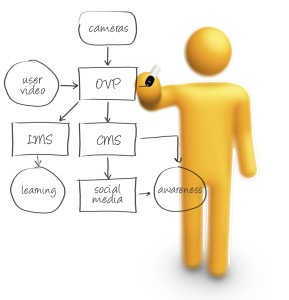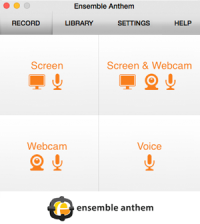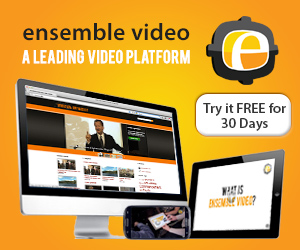10 Guidelines: How to Choose an OVP

For large organizations and institutions, the online video platform (OVP) landscape is riddled with overspending and failed product implementations. Avoid common pitfalls and ensure a sustainable OVP purchase that integrates with your tech infrastructure for a healthy digital media ecosystem.
Every day, we hear from experts in business, education, government, and the non-profit sector who are stuck in media management scenarios that lack clear direction and fall short of overall goals. You know YouTube isn’t enough. Your homegrown system is becoming increasingly unmanageable. And you’ve probably tried an open-source solution that ended up too complex, and full of hidden costs. We feel you.
You need an OVP that supports an open media ecosystem, allowing you to choose the best tools to suit your needs, and eliminating the risk of proprietary lock-in. You should be free to experiment with capture tools and software, without all the baggage that has traditionally driven decision-making, such as high switching costs, insufficient or under-skilled staff to manage open-source technology, or an inflexible and out of capacity data center.
We’re here to help you find a solution that grows with your needs, and evolves with the industry, empowering you to create an open, flexible, scalable, and sustainable digital media ecosystem. Let us help you navigate the market to successfully acquire, implement, and sustain an online video strategy that works for you, and not against you.
[sws_divider_line]
10 GUIDELINES: How to Choose an OVP for your Digital Media Ecosystem
 1. DEFINE YOUR NEED AND BUILD YOUR BUSINESS CASE
1. DEFINE YOUR NEED AND BUILD YOUR BUSINESS CASE
How can an OVP help you achieve your goals?
Consider and document your organization’s overall goals, and think about how video can facilitate them. Build a strong case, intended to convince staff and decision makers to get behind your solution. The strength of your business case is as important as the quality of the technology you choose. If you fail to prove the project’s value, it will be difficult to get support or funding
[sws_divider_line]
2. PINPOINT EXPECTATIONS AND DETERMINE BENEFITS
What does success look like?
Analyze and discuss expected short and long-term benefits from a strategic viewpoint, and illustrate these expectations to your stakeholders. Make sure they understand how the OVP will impact them. Will it make their lives easier? Increase revenue? Simplify training, support, and communications? Transform teaching and learning? Consider the viewpoints of your constituents, and also look ahead to what they may require of the OVP in the future. You can avoid many common pitfalls by carefully considering up-front and future costs for enhanced service.
[sws_divider_line]
3. TALK BUDGET AND GET SUPPORT FROM ABOVE
Do you have buy-in from higher ups, and a workable budget?
Armed with a comprehensive business case, and clearly defined expectations, set your sites on the managers and executives who will ultimately decide on purchasing the product. Some savvy decision-makers will have a number in mind. Others may want to understand the range of options, without cost being an immediate issue. The key is to ensure you have enough support to move forward. The road to choosing the right solution can be a long one. And the last thing you want is to get to the finish line, only to realize there’s no budget for your project.

[sws_divider_line]
4. IDENTIFY PROJECT REQUIREMENTS
What does the system need to impact your unique business case?
When purchasing an OVP, you should think carefully about your current challenges, and what you’re trying to accomplish. Don’t get stuck in the mud with a long feature list. Features are important, but it’s crucial to think big, and consider how a particular platform will impact your daily activities and transform your business. It’s easy to be seduced by bells and whistles, and to overpay for those bells and whistles, only to realize you have no return on your investment. Avoid this common pitfall by developing a list of project requirements that describe at a high level what the new system needs to support and accomplish for your organization.
[sws_divider_line]
5. DECIDE WHETHER TO GO OPEN-SOURCE OR LICENSED
Can you find a platform that’s flexible, powerful, and sustainable?
Time to evaluate your choices. There are some open-source and proprietary options, and some diamonds in the ruff if you truly do your homework. We won’t get into the age-old open-source vs. licensed software debate. The key is to find the right fit — an OVP that integrates smoothly into your digital media ecosystem. Project success tends to be much higher when an OVP can be threaded into existing and future platforms, as opposed to a stand-alone platform that doesn’t add value to previous investments. You also want to leave room to integrate new, complimentary technologies into your digital media workflow.
[sws_divider_line]
6. EVALUATE ROLL-OUT AND ADMINISTRATION
How easy or difficult is the OVP to roll out and administer?
 Determine how you would like to manage the system and roll it out to users. Some platforms are very centralized, while others offer distributed administration options, along with hybrid approaches. It’s important to understand the culture of the platform. What authentication sources are supported? What variety of users roles are offered? How will the platform scale? You will want to make sure you have a powerful management toolset that provides complete control over your OVP solution. And, the delivery and management of this solution to end-users must be easy and intuitive, or you will end up with frustrated workers who are not using the product you just paid for. By empowering your users and stakeholders with the right OVP, you can meet your business goals and transform your organization in an efficient and effective manner.
Determine how you would like to manage the system and roll it out to users. Some platforms are very centralized, while others offer distributed administration options, along with hybrid approaches. It’s important to understand the culture of the platform. What authentication sources are supported? What variety of users roles are offered? How will the platform scale? You will want to make sure you have a powerful management toolset that provides complete control over your OVP solution. And, the delivery and management of this solution to end-users must be easy and intuitive, or you will end up with frustrated workers who are not using the product you just paid for. By empowering your users and stakeholders with the right OVP, you can meet your business goals and transform your organization in an efficient and effective manner.
[sws_divider_line]
7. EXAMINE MIGRATION AND DEPLOYMENT OPTIONS
Does your platform offer flexible deployment options? How hard is it to launch the new system?
Deployment options are a major differentiator between OVP’s. Be sure to have a clear understanding of the different types of OVP deployments on the market — there are self-hosted, cloud-hosted, hybrid, and multi-tenant video platforms. Determine which setup is the best fit for your organization’s unique structure and media goals, and know the deployment options offered by each vendor. Your organization will have specific needs (control, SaaS, price, etc.) driving you to one of the above deployment options, so be sure to consider them. Lastly, make sure you understand how hard or easy it is to migrate existing content, as well as content from another OVP, or from one deployment option to another.
[sws_divider_line]
8. KNOW THE COMPANY BEHIND THE PLATFORM
Does the company understand your needs, and are they willing to do anything to support you?
By this time, you have probably developed an opinion about the solutions you’ve looked at, and you may even have a front-runner. Now, it’s important to dig a little deeper into the company behind the product. What do they value? What do they focus on? You should also have a strong understanding of who their existing clients are, and what those clients are saying about their software and technical support. Tech support is another major differentiator between OVP’s. You want to work with a team that understands your needs and will expend as much energy as possible to meet them. As you know, reality can be a bit different from what a sales professional tells you, or what a website says. And in many cases, the smaller OVP can support you better than the 800-pound gorilla.
[sws_divider_line]
9. CONSIDER THE OVP’S VISION AND ROADMAP
What’s on the horizon?
After learning more about the support and customer service provided by the OVP, it’s also important to understand their product roadmap. Make sure their forecast can be aligned with your own short-term and long-term goals, including the specific technology solutions you will need to help you meet those goals. If you ask your OVP for its product roadmap, you will have a mechanism to help anticipate and plan around technology developments. The roadmap also provides a framework to help plan and coordinate your own project developments.
[sws_divider_line]
10. EVALUATE THE COST OF THE PROJECT
Are we over-spending?
One of the great things about the OVP market is that there are hundreds of options, and the cost ranges anywhere from zero, to seven-figures. Once again, it’s crucial to find the best fit for your organization, before you sign on the dotted line. You could use a free or open-source option, and end up with headaches because it’s clunky and difficult to manage. Or, you could overspend on the most expensive product, and not realize a return on your investment. Think about when you purchase a car — consider the Ferrari vs. the Toyota. What do you truly need to get from point A to point B? Which bells and whistles can you live with, and which can you live without? We would all love to drive the Ferrari really fast, but maybe the Toyota is a better option if we’re not on the racing circuit. Think about your OVP in the same way. The high-end options are great if you’re in the video business, and need all those features to be successful. On the other hand, if video is not your core business, but it can enhance and improve your organization, maybe you should consider the Toyota.
[sws_divider_line]
THE TAKE-AWAY
At the end of the day, there’s no one-size-fits-all OVP solution. But there’s also no question that the online video superhighway is growing and flowing, exponentially. Give us a call or drop us a line. We can help create a tailored strategy that empowers you to race forward, and not end up stranded on the side of the road!















You must be logged in to post a comment Login